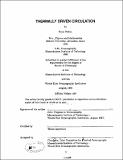Thermally driven circulation
Author(s)
Nelken, Haim
DownloadFull printable version (9.855Mb)
Alternative title
Circulation, Thermally driven
Other Contributors
Woods Hole Oceanographic Institution.
Advisor
Glenn R. Flierl
Terms of use
Metadata
Show full item recordAbstract
Several problems connected by the theme of thermal forcing are addressed herein. The main topic is the stratification and flow field resulting from imposing a specified heat flux on a fluid that is otherwise confined to a rigid insulating basin. In addition to the traditional eddy viscosity and diffusivity, turbulent processes are also included by a convective overturning adjustment at locations where the local density field is unstable. Two classes of problems are treated. The first is the large scale meridional pattern of a fluid in an annulus. The detailed treatment is carried out in two steps. In the beginning (chapter 2) it is assumed that the fluid is very diffusive, hence, to first approximation no flow field is present. It is found that the convective overturning adjustment changes the character of the stratification in all the regions that are cooled from the top, resulting in a temperature field that is nearly depth independent in the northernmost latitudes. The response to a seasonal cycle in the forcing, and the differences between averaging the results from the end of each season compared to driving the fluid by a mean forcing are analyzed. In particular, the resulting sea surface temperature is warmer in the former procedure. This observation is important in models where the heat flux is sensitive to the gradient of air to sea surface temperatures. The analysis of the problem continues in chapter 5 where the contribution of the flow field is included in the same configuration. The dimensionless parameter controlling the circulation is now the Rayleigh number, which is a measure of the relative importance of gravitational and viscous forces. The effects of the convective overturning adjustment is investigated at different Rayleigh numbers. It is shown that not only is the stratification now always stable, but also that the vigorous vertical mixing reduces the effective Rayleigh number; thereby the flow field is more moderate, the thermocline deepens, and the horizontal surface temperature gradients are weaker. The interior of the fluid is colder compared to cases without convective overturning, and, because the amount of heat in the system is assumed to be fixed, the surface temperature is warmer. The fluid is not only forced by a mean heat flux, or a seasonally varying one, but its behavior under permanent winter and summer conditions is also investigated. A steady state for the experiments where the net heat flux does not vanish is defined as that state where the flow field and temperature structure are not changing with time except for an almost uniform temperature decrease or increase everywhere. It is found that when winter conditions prevail the circulation is very strong, while it is rather weak for continuous summer forcing. In contrast to those results, if a yearly cycle is imposed, the circulation tends to reach a minimum in the winter time and a maximum in the summer. This suggests that, depending on the Rayleigh number, there is a phase leg of several months between the response of the ocean and the imposed forcing. Differences between the two averaging procedures mentioned before are also observed when the flow field is present, especially for large Rayleigh numbers. The circulation is found to be weaker and the sea surface temperature colder in the mean of the seasonal realizations compared to the steady state derived by the mean forcing. As an extension to the numerical results, an analytic model is presented in chapter 4 for a similar annular configuration.
Description
Thesis (Ph. D.)--Joint Program in Oceanography (Massachusetts Institute of Technology, Dept. of Earth, Atmospheric, and Planetary Sciences; and the Woods Hole Oceanographic Institution), 1987. Includes bibliographical references (leaves 181-186).
Date issued
1987Department
Joint Program in Oceanography; Woods Hole Oceanographic Institution; Massachusetts Institute of Technology. Department of Earth, Atmospheric, and Planetary SciencesPublisher
Massachusetts Institute of Technology
Keywords
Joint Program in Oceanography., Earth, Atmospheric, and Planetary Sciences., Woods Hole Oceanographic Institution.